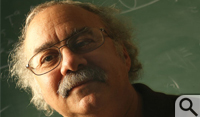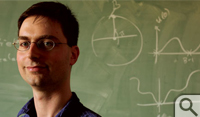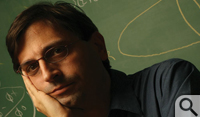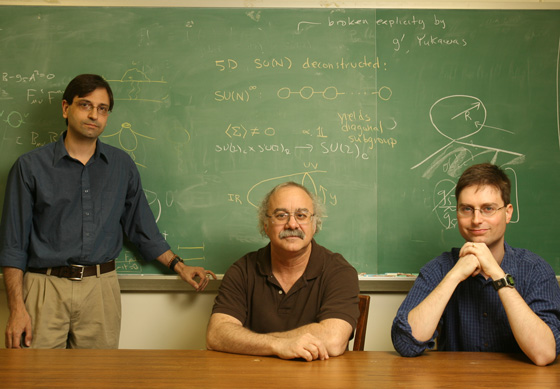Approaching the altar of the 'god particle'
Physicists hope the Large Hadron Collider will reveal exactly how mass begins
Consider the Higgs boson--everybody else is. Everybody involved in theoretical particle physics, that is.
The Higgs boson is the top seed among informed scientific speculation as a key to a puzzle: How do particles get mass? Put another way, what makes anything a thing, as opposed to everything being one form of energy or another? It's a fundamental question that most of us don't even think about, but think about this: Apples (and most everything else) had been falling to earth long before Newton thought that the same force that makes apples fall also keeps the moon in its orbit.
Particle physics theory is based on what is known as the Standard Model, an understanding of a number of elementary particles and their interactions. Over the years, many theoretical  aspects of the Standard Model have been verified by experiment but even as the blanks are filled in, one big question remains.
aspects of the Standard Model have been verified by experiment but even as the blanks are filled in, one big question remains.
"Why do all particles have mass? It's something that doesn't currently have an experimental answer," said Christopher Carone, associate professor of physics and a member of the High Energy Theory Group. "The Standard Model is a successful theory in that what it describes it does to great precision-that's something that's been confirmed by experiment. But there's a sector of the theory that has to be put in that explains why the particles we're studying aren't all massless. So that's a pretty important question. That sector of the theory has new particles in it. The LHC will be directly probing that sector of the Standard Model that will explain the origin of mass."
Anticipation of the theorists
 Carone and the other two members of William and Mary's High Energy Theory Group, Joshua Erlich and Marc Sher, have professional interest in the anticipated summer 2008 startup of the LHC-the Large Hadron Collider (see sidebar). They've spent substantial portions of their careers formulating answers to what might be found when protons start colliding under the landscape of two nations and they are aware of the magnitude of the event.
Carone and the other two members of William and Mary's High Energy Theory Group, Joshua Erlich and Marc Sher, have professional interest in the anticipated summer 2008 startup of the LHC-the Large Hadron Collider (see sidebar). They've spent substantial portions of their careers formulating answers to what might be found when protons start colliding under the landscape of two nations and they are aware of the magnitude of the event.
"You can think about the importance of it on the scale of William and Mary's existence," said Sher, professor of physics. "About the time William and Mary started, Isaac Newton came up with a description of what mass was. And now in the next two or three years, we're finally going to find out how mass arises. Kinda cool."
The Higgs boson is the theoretical missing link between massless particles and elementary particles having mass. It's been dubbed "the god particle" by physicist superstar Leon Lederman, a characterization that Carone says "probably makes all particle physicists just cringe, but which probably helped to sell a few of his books."
...or something like it
 When Carone, Erlich or Sher speak of the Higgs boson, they are always careful to add "...or something like it." The three aren't necessarily Higgs skeptics, although they have collaborated on a Higgsless theory of the origin of mass.
When Carone, Erlich or Sher speak of the Higgs boson, they are always careful to add "...or something like it." The three aren't necessarily Higgs skeptics, although they have collaborated on a Higgsless theory of the origin of mass.
Their theoretical work has dealt with not only the main question of the origin of mass, but also interesting phenomena-such as the formation of black holes and evidence of extra dimensions-that might be revealed by the LHC detectors. Theory, they say, acts as the bread in a scientific sandwich, with experiment as the filling.
"Our job as theoretical particle physicists is sort of two-fold," Erlich said. "One, we try to anticipate what could be seen. You have to do that in order to know what to look for. Then the experimentalists go look for that. At the Large Hadron Collider, the experimentalists feed back to us what was actually seen. Then we come to the second part of our job-interpreting what is actually seen in the context of the predictions that we've been making."
There are some problems with the Higgs boson, even in theory. Erlich explained that a theoretical Higgs boson, inserted into a Standard Model calculation, comes out immensely heavier-"some factor of 1016 times too heavy to be consistent with current experiments," he said. To make the Higgs boson work, theorists posit a number of special conditions. Very special conditions.
"Maybe it's there, maybe the Higgs boson really is as light as it has to be, but it's a mystery why," Erlich said. "Now in order to try to understand why the Higgs would be as light as it has to be in order to be consistent with current experiments, then some miraculous possibilities pop up. If there are extra dimensions of space, that could help explain why the Higgs boson would be so light. If there is supersymmetry, which predicts all sorts of new particles that haven't been seen so far-some of which would be detected at the Large Hadron Collider-that could explain why the Higgs boson would be so light. These possibilities are really grandiose and we might actually see evidence, for example, of extra dimensions, if those ideas are correct. Those are the kinds of things we like to think about."
Why we need extra dimensions
 Carone said he is less interested in the LHC's potential to reveal the Higgs boson than he is in the possibility of finding evidence of extra dimensions, particularly as they relate to string theory-a theoretical attempt to reconcile gravity with the three fundamental natural forces (electromagnetism, the strong force and the weak force) into what has been dubbed "the theory of everything." String theory, he said, requires the existence of extra dimensions to work.
Carone said he is less interested in the LHC's potential to reveal the Higgs boson than he is in the possibility of finding evidence of extra dimensions, particularly as they relate to string theory-a theoretical attempt to reconcile gravity with the three fundamental natural forces (electromagnetism, the strong force and the weak force) into what has been dubbed "the theory of everything." String theory, he said, requires the existence of extra dimensions to work.
"First of all, how could there be more dimensions than we perceive? If there was an extra dimension that I couldn't perceive directly, I could still imagine that I push Marc and he falls off into the extra dimension," Carone said. "He might not disappear, but just get farther away. He might get dimmer because he's actually farther away in this other dimension and the photons are more spread out."
Further, he explained, string theory says that the extra dimensions are not infinite in extent, but compactified so they form a circle. If Carone were to shove Sher hard enough, he’d go clear around the extra-dimension loop, eventually coming back to where he started from. No professors will be shoved into extra dimensions in the foreseeable future, but the LHC experiments may generate post-collision phenomena-energy loss, disappearing particles—that can be explained by extra dimensions.
"That is like science fiction. The Large Hadron Collider might be an extra-dimension gun. You shoot things and they disappear into the extra dimensions," Erlich said.
"When the extra dimensions start shooting back," Sher added, "then we have to worry."
Sher noted that extra dimensions, supersymmetry and other explanations for the lightness of the Higgs boson are separate questions from the quest to discover the Higgs boson itself (or something like it).
The nightmare scenario
"The nightmare scenario is that they find the Higgs and nothing else. No Higgs would be more interesting than just a Higgs," Sher said. "It turns out that a particular interaction probability becomes infinite if you do not have a Higgs, which obviously is nonsense. The Higgs-or something like it-is the only way we know how to stop that from happening. So, in a way, having no Higgs means something goes to infinity at some point and the fact that that doesn't happen is going to tell us something."
Members of the High Energy Theory Group won't have to go to Europe to keep tabs on data from the LHC, because, as Carone says, "the Internet is a very good thing." The proton beams in the LHC will generate a trillion collisions a second-more than can possibly be recorded, let alone analyzed.
Results from the LHC will be released in a stream of scientific papers posted on websites, the usual orderly, cautious scientific manner of disseminating information. But Sher doesn't see his colleagues around the world waiting to read papers.
"The way it will happen is that there will be rumors," he said. "When you have a thousand people, there are going to be leaks. So there will be these rumors that they see a bump that was not expected. There are always bumps in the data, because it's statistical. Then the three of us will say, 'Did you hear about that bump?' Then we'll all start to think about what could make that bump. So will everybody else; some people will even write papers. By the time the bump is confirmed, there already will be dozens of papers on it. Most likely the bump goes away, so those dozens of papers become meaningless."
Bumps and other data relayed from the LHC have enormous significance to the world's thousands of theoretical physicists, including, of course, those at William and Mary. What goes on in the LHC will, as noted, require interpretation, but it also will set the course of future theoretical inquiry and show the relevance-if any-of work to date."
"It's interesting that 90 percent of all the papers that I've written in my career are, within the next five years, going to be gone, dead, meaningless. But I just don't know which 90 percent,” Sher said. "That's fine. It's expected. If you weren't having your theories ruled out, you wouldn't be doing a very good job."
Physicists aren't sure what they will see revealed within the chambers of the LHC. It could be the Higgs boson. It might be something like it. The one thing they don't expect to see is nothing.
"When people ask the question, 'What if the LHC doesn't see anything?,' Most of the time it's a misguided question," Carone said. "People have this idea it's like a box and if I open the box, I'll either find something or not find something. That's too simplistic a way to approach this. We have theories now that work and they're based on quantum mechanical principles that will go haywire if we don't see anything. So there is strong reason to believe that something will be there. Now the Higgs boson, the minimal Higgs boson, is probably the simplest model that you can write down that works. But what are the chances that the first stab at the simplest model will turn out to be the exact mechanism that's realized in nature? So I think the safest bet is that something is there, but the excitement is that we don't really know what it is-and there's a wide variety of possibilities." 















